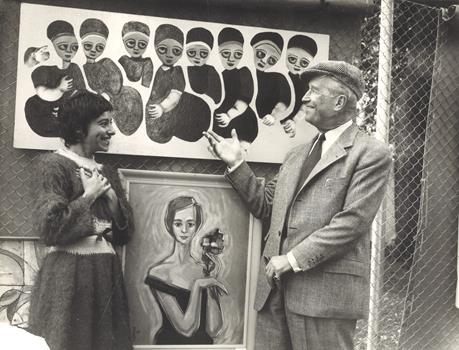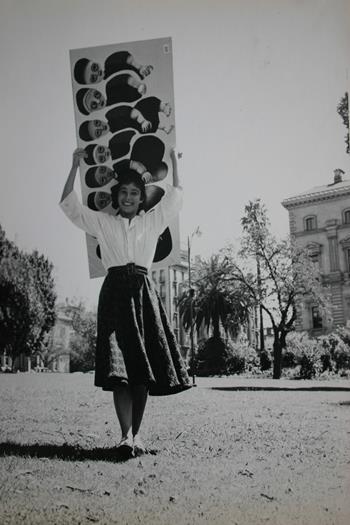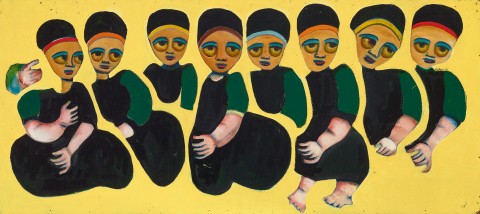SELF PORTRAITS, 1960
MIRKA MORA
enamel and oil on composition board
61.0 x 137.0 cm
signed and dated centre right: MiRKA 60
The Estate of Mirka Mora, Melbourne
Herald Outdoor Art Show, Melbourne, 4 – 12 March 1960 (as ‘People’)
Where Angels Fear to Tread : 50 Years of Art 1948 – 1998, Heide Museum of Modern Art, Melbourne, 1999 – 2000, pp. 27 (illus.), 62
Mora, M., Delany, M., and White, M., Mirka Mora : where angels fear to tread : 50 years of art 1948 – 1998, Heide Museum of Modern Art, Melbourne, 1999, p. 27 (illus.)
Cotte, S., Mirka Mora: A Life Making Art, Thames & Hudson, Melbourne, 2019, p. 64 (illus., as ‘People’)
210140 Mirka Mora and Maurice 1960.jpg

‘There was nobody, and there never will be, anyone like Mirka Mora… She was an incredible mix of wisdom, cheekiness and childhood innocence… the kind of person who could light up a room and [she] will always have a legion of fans because she had a special gift for making everyone feel special.’1
Hailed as ‘a veritable national treasure’2, Mirka Mora remains arguably one of the most beloved and original figures in Australia’s cultural life, with her delightfully eccentric, inimitable personality capturing the public imagination as much the enchanting, fantasy world immortalised in her art. Having survived the horrors of the Holocaust, the Parisian-born artist, along with her husband Georges, and infant son Philippe emigrated from post-war France to Melbourne in 1951, where they quickly settled into the local bohemian scene. From their apartment-studio in the ‘Paris End’ of Collins street, Mirka worked initially as a dressmaker (while also making art), and Georges became an influential art dealer, adding – with his flair and entrepreneurship – Tolarno Galleries to Melbourne’s only very select number of commercial art galleries in 1967. The couple also owned and operated various landmark European style cafes and restaurants, including the Mirka Café in Exhibition Street (which was the venue for the first major solo exhibition by Joy Hester); the Café Balzac in Wellington Parade, East Melbourne; and Tolarno in Fitzroy Street, St Kilda, where Mirka created an ambitious series of sumptuously embellished, large scale murals that have since become among her most celebrated and enduring public works.
With their open and fearless attitude to life, generous hospitality and infectious personalities, the pair contributed immeasurably to the progressive subculture of avant-garde thought, activism, and creativity that was emerging in conservative Melbourne at the time – thus attracting a new wave of artists, writers, collectors and intellectuals, many of whom would become luminaries of Australian art, including John and Sunday Reed (founders of Heide, now Heide Museum of Modern Art); Fred Williams; Joy Hester; Sidney Nolan; Arthur Boyd and Charles Blackman. As Barbara Blackman recalls in her memoirs, ‘Georges and Mirka had come from the heart of that war wounded Europe which we, in our protected isolation, were only slowly coming to understand… They were happeners, not owners. They had lost families, home, land of birth, friendships, memorabilia of youth, and lived in the focus of the present, its possibilities… Good food and good conversation, that was their stock in hand… certainly Georges ‘grew us up’, as assuredly as Mirka never let us escape our child-hearted spontaneity.’3
210140 Mirka carrying People.jpg

A compelling example of Mirka’s distinctively naïve and richly decorative style, Self Portraits, 1960 illustrates well the artist’s love and nostalgia for the innocence of childhood. Here the large, wanting eyes of the multiple self-portraits not only betray an unmistakable likeness to images of Mirka as a child; moreover they evoke, as the artist herself elucidates, a deep emotional longing and empathy for the children of her own age killed in the holocaust. Significantly however, where earlier self-portraits of the late 1950s are characterised by a certain gravity and psychological burden – for example, Self Portrait, 1958 featuring a lone child in ecclesiastical dress who is at once framed and constrained by a large upright chair, set against an emotionally intense, predominantly red ground – the present, with its frieze-like format, sumptuous colour and mysterious, almost Byzantine feel exudes a lighter, more playful or theatrical sense, no doubt inspired by Mirka’s enduring interest in Surrealism and the festive traditions of the Comédies Italiennes. Perhaps not surprisingly, Self-Portraits, 1960 was much admired by famous French singer and actor, Maurice Chevalier, upon its inaugural exhibition in the Herald Outdoor Art Show, held in Melbourne in 1960. As Mirka recalls in her autobiography, My Life: Wicked but Virtuous: ‘…[Maurice] was staying at the Windsor Hotel and I would meet him in the Fitzroy Gardens, pushing my big pram with Tiriel in it. M. Chevalier loved a large painting I had in the Herald Art Show at the time and understood my soul. I have a picture of Maurice Chevalier and me, and he insisted that we be photographed with the painting. We had long conversations about one’s dedication to one’s art…’4
Although most modernist perceptions at the time could not quite accommodate the ‘medieval’ vocabulary, rich symbolism and ornate decoration of her achievements, today critics universally appreciate that the power of Mirka’s artistic legacy lies precisely in this magical world of beauty, love and joy which, although derived from the enormous trauma and suffering she experienced as a child, nevertheless celebrates the human condition, its resilience and the miracle of survival. As Patrick McCaughey (who would later become Director of the National Gallery of Victoria) astutely observed ahead of his generation, ‘… [Mirka’s] fantasies are not a way of escaping from the world but a way of participating in it. They redeem it from its mundanity, transforming it into a magical zone… we are fortunate that Mirka Mora has shared her experience of the world with us so intimately. It is a bright world to enter and difficult to leave…’5
1. Lesley Harding, cited in Dore, M., ‘The second-hand life lessons of artist Mirka Mora’, Extraordinary Routines,
2. Carrillo Gantner, cited in Cotte, S., Mirka Mora: A life making art, Thames and Hudson, Melbourne, 2019, p.11
3. Blackman, B., ‘The Good Ship Mora, Melbourne in the fifties’, Meanjin, vol. 55, no. 2, 1996, pp. 293 – 305
4. Mora, M., My Life: Wicked But Virtuous, Penguin Random House, Australia, 2000, p. 57
5. McCaughey, P., ‘Fantasy key to the world’, The Age, 7 June 1967, p. 8
VERONICA ANGELATOS
